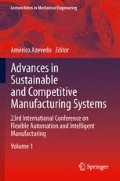Abstract
Open Architecture Product (OAP) offers public interfaces beyond the individual product. The interface can be shared by other products to enrich the product function and adaptability. Adaptable design (AD) meets OAP objectives for different requirements through modification or adaptation of product modules in the product lifecycle. The product adaptability is achieved by adaptable design, adaptable modules and platforms, and interfaces. This paper introduces a miniature electric vehicle with open architecture developed using AD. The electric vehicle consists of common platforms, customized modules, and user personal components. The vehicle developed can easily meet the individualization of users’ requirements and requirement changes in its lifecycle.
Access this chapter
Tax calculation will be finalised at checkout
Purchases are for personal use only
References
Horbach S, Ackermann J, Mulle E, Schutze J (2011) Building blocks for adaptable factory systems. Robot Comput-Integr Manuf 27:735–740
Briere-Cote A, Rives L, Desrochers A (2010) Adaptive generic product structure modeling for design reuse in engineer-to-order products. Comput Ind 61:53–65
Park Y, Fujimoto T, Hong P (2012) Product architecture, organizational capabilities and IT integration for competitive advantage. Int J Inf Manage. doi:10.1016/j.ijinfomgt.2011.12.002
Gu P, Xue D, Nee AYC (2009) Adaptable design: concepts, methods and applications. Proc Inst Mech Eng Part B: J Eng Manuf 223(11): 1367–1387
Ulrich KT (1995) The role of product architecture in the manufacturing firm. Res Policy 24(3):419–440
Shibata T, Yano M, Kodama F (2005) Empirical analysis of evolution of product architecture: Fanuc numerical controllers from 1962 to 1997. Res Policy 34:13–31
Hassan S, Anwer N, Khattak Z, Yoon JW (2010) Open architecture dynamic manipulator design philosophy (DMD). Robot Comput-Integr Manuf 26:156–161
Koren Y, Pasek ZJ, Ulsoy AG, Benchetrit U (1996) Real-time open control architectures and system performance. CIRP Ann-Manuf Technol 45(1):377–380
Koren Y (1998) Open-architecture controllers for manufacturing systems. Open architecture control systems–summary of global activity, pp 15–37
Wrigh PK (1995) Principles of open-architecture manufacturing. J Manuf Syst 14(3):188–202
Gu JS, Silva CW (2004) Development and implementation of a real-time open-architecture control system for industrial robot systems. Eng Appl Artif Intell 17:469–483
Grigoriev SN, Martinov GM (2012) Scalable open cross-platform kernel of PCNC system for multi-axis machine tool. Procedia CIRP 1:238–243
Li P, Gao T, Wang J, Liu H (2010) Open architecture of CNC system research based on CAD graph-driven technology. Robot Comput Integr Manuf 26:720–724
Shacham M, Brauner N, Cutlip MB (2010) Open architecture modelling and simulation in process hazard assessment. Comput Chem Eng 24:415–421
Ferrer G (2010) Open architecture, inventory pooling and maintenance modules. Int J Product Econ 128:393–403
Gu P, Hashemina M, Nee AYC (2004) Adaptable design. CIRP Ann Manuf Technol 53(2):539–557
Xue D, Hua G, Mehrad V, Gu P (2012) Optimal adaptable design for creating the changeable product based on changeable requirements considering the whole product life-cycle. J Manuf Syst 31:59–68
Francalanza E, Borg JC, Constantinescu CL (2012) A case for assisting ‘product family’ manufacturing system designers. Procedia CIRP 3:376–381
Tseng MM, Jiao RJ, Wang C (2010) Design for mass personalization. CIRP Ann Manuf Technol 59:175–178
Koren Y, Heisel U, Jovane F, Moriwaki T, Pritschow G, Ulsoy G, Brussel HV (1989) Reconfigurable manufacturing systems. CIRP Ann Manuf Technol 48(2):527–540
Makris S, Michalos G, Eytan A, Chryssolouris G (2012) Cooperating robots for reconfigurable assembly operations: review and challenges. Procedia CIRP 3:346–351
Peters BA, Rajasekharan M (1996) A genetic algorithm for determining facility design and configuration of single-stage flexible electronic assembly systems. J Manuf Syst 15(5):316–324
Ulrich KT, Eppinger SD (2000) Product design and development. McGraw-Hill, New York
Ma J, Kwak M, Kim H (2012) Pre-life and end-of-life combined profit optimization with predictive product lifecycle design. Proceedings of the ASME IDETC/CIE 2012, DETC2012-70528
Löffler C, Westkämper E, Unger K (2012) Changeability in structure planning of automotive manufacturing. Procedia CIRP 3:167–172
Martin MV, Ishii K (2012) Design for variety: developing standardized and modularized product platform architectures. Res Eng Des 13(4):213–235
Li Y, Xue D, Gu P (2008) Design for product adaptability. Concurr Eng 16(3):221–232
Pahl G, Beitz W (1988) Engineering design: a systematic approach. Springer, Berlin
Acknowledgments
The Natural Sciences and Engineering Research Council (NSERC) of Canada. The Leading Talent Project of Guangdong Province, China.
Author information
Authors and Affiliations
Corresponding author
Editor information
Editors and Affiliations
Rights and permissions
Copyright information
© 2013 Springer International Publishing Switzerland
About this paper
Cite this paper
Peng, Q., Liu, Y., Gu, P., Fan, Z. (2013). Development of an Open-Architecture Electric Vehicle Using Adaptable Design. In: Azevedo, A. (eds) Advances in Sustainable and Competitive Manufacturing Systems. Lecture Notes in Mechanical Engineering. Springer, Heidelberg. https://doi.org/10.1007/978-3-319-00557-7_7
Download citation
DOI: https://doi.org/10.1007/978-3-319-00557-7_7
Published:
Publisher Name: Springer, Heidelberg
Print ISBN: 978-3-319-00556-0
Online ISBN: 978-3-319-00557-7
eBook Packages: EngineeringEngineering (R0)

